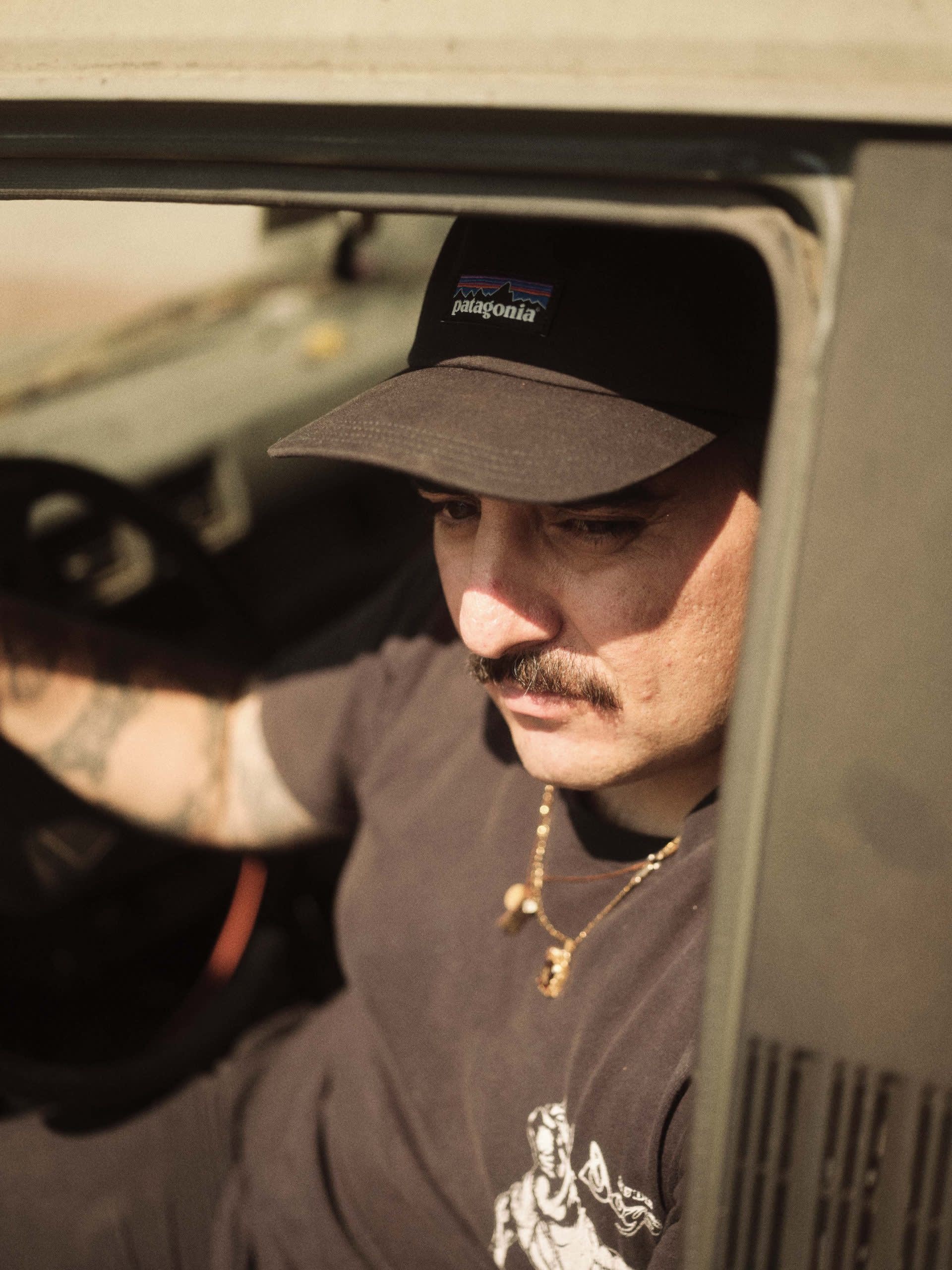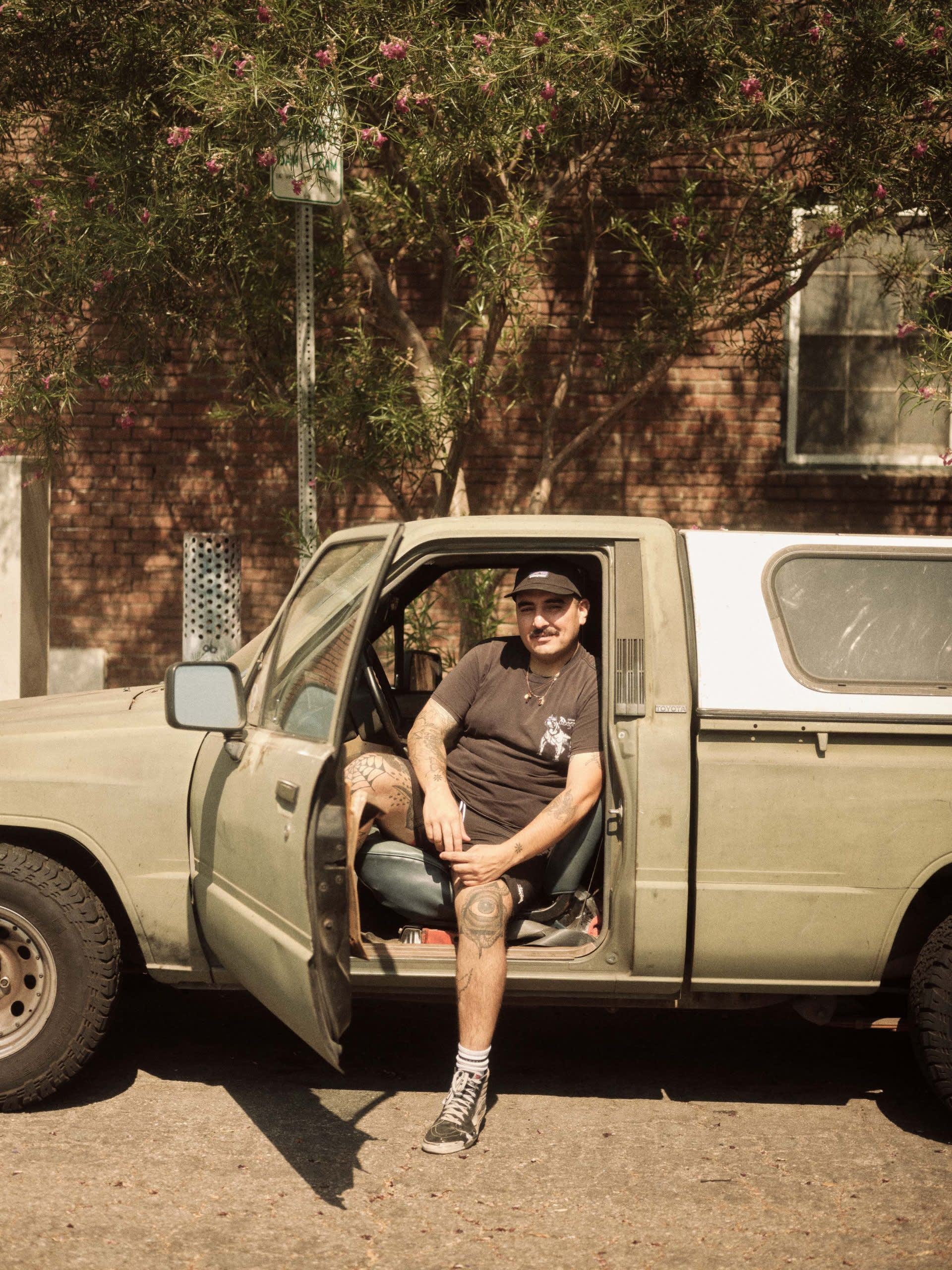
Artist Jaime Muñoz draws from a range of shared experiences with his community and from his upbringing to explore ideas surrounding colonial history and the notion of modernity, ancestral memory and identity, and the mechanization of human labor as it relates to the working class experience and self. Muñoz’s pieces are painterly and employ bold colors, glitter, layering of paper and some uncustomary techniques that he has adopted from his builder background. But his compositions undoubtedly reveal his graphic design education—balanced, precise, layered, and grid-like. On a hot summer day, I visited Muñoz’s studio in Pomona, where he both lives and works. We spoke about his early entrance into the workforce as a construction worker, the idea of “blood memory,” why he works with a range of different materials, and what he’s looking forward to exploring in the near future.
Tell me about your upbringing and what your family was like.
I’m the first generation to be born in the United States, so I grew up traditionally Mexican, and very working class. I was brought up around a lot of discipline and work, and for the most part I grew up with a single mother. My dad was in and out of the picture.

Was there a specific reason your parents came here?
For a better life and better opportunity. My early upbringing heavily informed my identity as a person and as an artist. Some of the things that I really focus on in my work are ideas around the colonial period, because I grew up very Catholic. I also explore ideas of commodification of the human body through labor. I didn’t go to school right out of high school because that wasn’t the plan or the option. My only option was to go straight into the workforce and I worked in construction with immigrants for a number or years. Being exposed to that experience definitely got me thinking about things differently.
I thought I was going to be doing that for the rest of my life, but I did have ambition to pursue art and I was pursuing it independently on the weekends, just in my room painting. I didn’t have anything going, so I think it’s great when the motivating factors are external things. I just wanted to create and make work. I had no expectations or desire really to show it. I just wanted to create. I’ve reflected and thought about the idea of labor and commodity work, and it’s dehumanizing. During the week, I felt very dehumanized and on the weekend, creating, it was my therapy and made me feel human.

How do you explore your Chicano identity in your artwork?
I identify as Chicano, but I don’t know if I identify my work as Chicano art, you know? But it does reflect my identity, especially the themes I’m exploring. Part of my intention of exploring those chronological themes is exploring the unseen aspects of the history we were brought up in. I wasn’t taught about Latin American colonial art, but I grew up around it my whole life. I wasn’t taught about colonial history, but I was taught the history of modernity and how that was seen as a period of progress, like manifest destiny. I was taught that it was progress. The Chicago World Fair is a testament to the progress of colonialism.
When I was really looking at the history as it relates to my experience, I was fascinated with working class history from the period of modernity, the turn of the century, like the Industrial Revolution period—labor unions, ethics around the workplace, and part of that progress was the commodification of labor and the mechanization of it. That’s the part that makes me feel not human. That’s not taught. What’s taught is, “colonialism, wow look at the progress we’ve made,” but it’s really rooted in racism. If you look at Chicano history, there was a period where it wasn’t intended for us to pursue higher education. There’s proof in the identity of the country that we were intended to make other people’s lives easier. The myth of the American Dream wasn’t intended for us, or at least I felt that way.

Tell me about this term that you’ve sort of coined in your work, “toyoteria.” Can you explain how you came up with that term?
I’m really fascinated with how things surface in popular culture like in small demographics of people. In car culture, I felt like there’s a blank spot or a missing link to something that I saw or was experiencing. When you think of Chicanos and car cultures, you think of lowriders. I love lowriders and what they represent is what I’m trying to do too. They’re using these machines that were once synonymous with modernity and futurism, and instead of taking them further than that, they’re doing the opposite. They’re dropping it, making it go slow. So it’s very radical in that sense. I personally was never into lowrider culture—growing up in the working class, I always had experiences with working trucks and utility trucks, specifically with Toyota mini trucks. There’s almost a culture based around it in the working class that is all based around economic necessity. I see the use of the Toyota truck in my work as a way to use it as a symbol of commodity labor, the dehumanizing aspect that I’m talking about, and making it visible. In the conversation of identity, there’s an unseen part. So I want to make the unseen part more visible without being so literal. How do I make that feeling more visible? The “toyoteria” thing developed little by little on its own. It first started in real life with me having one and really participating in the culture of it. Waking up in the morning, going to work, you see them—at the gas station fueling, you understand each other. You’ll see them in the junkyards looking for parts. There was something about the culture that I was drawn to. My girlfriend thought of the word “toyoteria.”

I’d like to talk about a specific concept you touch on in your work called “blood memory.” Can you explain what “blood memory” entails and how it manifests in your work?
The whole idea of “blood memory” comes out of a conversation with my friend Mel while I was working on this painting where I was exploring the history of the apparition of Fátima. I thought it was interesting that these people were going out to the desert to experience these apparitions of Fátima as the dancing sun. I forget how I was describing it at the time, but I was talking with Mel and I was like, “They were worshipping the sun like an aspect of their native past was surfacing.” And she was like, “Oh yeah it’s like blood memory. It’s like a connection to your blood heritage that cannot be erased and it surfaces in your identity.” I was so interested in that because it exists just like how you inherit aspects of your character and trauma. I feel like there are aspects of your memory or things from your past that you carry with you forever.
For more from Jaime Muñoz, follow @flan_jm on Instagram.
Photography by Wray Sinclair.

